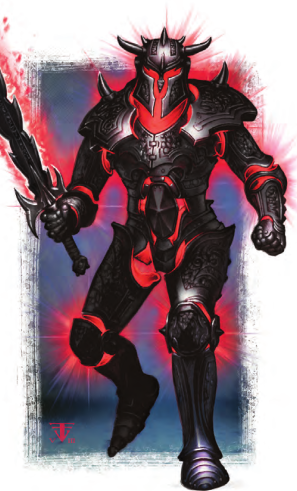Let's Read the 4e Monster Manual/Vault: Helmed Horror

This article is part of a series! Click here to see the other entries.
I first remember seeing Helmed Horrors in Neverwinter Nights, which used the 3e rule set. It’s quite possible they’ve been in the game since AD&D, though. Here, they’re only on the MM.
The Lore
Helmed Horrors are one of the many constructs-that-are-not-golems. They’re created by means of an ancient ritual just like golems, but have several practical differences.
First, the ratio of matter to elemental energy is different. The physical body of a helmed horror is a suit of plate armor, not a solid statue. This suit is filled with a much greater amount of energy pulled from the Elemental Chaos, enough to give the horror a coruscating aura and to infuse its weapon attacks with elemental damage. This also gives them the ability to regenerate.
Mentally, Helmed Horrors are smarter and have a bit more personality, though they’re still completely loyal to their creators. They can speak, and they have excellent senses (including both darkvision and truesight). They’re typically given greatswords as weapons, and are used for much the same purposes as a golem: guardians, bodyguards, or remorseless muscle.
Given their greatly enhanced senses and their trained skills, I imagine it’s also possible for a helmed horror to be used as a bounty hunter or city guard, possibly accompanied by organics who handle the more delicate social tasks.
The Numbers
We get two helmed horror stat blocks here. Both are Medium Elemental Animates (constructs) with training in Perception and Insight, plus Darkvision and Truesight. They speak Common and Primordial, and have human-level intelligence (one has 10, the other 12).
Helmed Horrors are immune to charm, disease, fear, poison and sleep, a greater suite of immunities than even some golems get. They also have varying levels of Regeneration and the ability to fly at the same speed they walk, though they do so clumsily.
Helmed Horror
The basic model is a Level 13 Soldier with 131 HP and all common traits above. Its regeneration is 5, and its speed is 6 both on the ground and in the air.
The horror’s Elemental Greatsword does a mix of physical damage and one of cold, fire, lightning or thunder, chosen before each attack is rolled. Its damage is “naturalistic”, but the bonus elemental damage manages to get to just a couple of points less than its correct value.
Once per encounter the horror can perform a Blade Sweep to attack two different targets, and it has a Tactical Step ability that allows it to shift 2 squares when it hits with an opportunity attack.
Greater Helmed Horror
This is a Level 18 Elite Soldier with 348 HP, which at first glance looks like it puts it on a roughly even footing with stone or iron golems. However, that’s not quite true.
The Greater Helmed Horror is basically a leveled-up version of the basic model. Its Regeneration is 10, its speed 8 in all movement modes, its Tactical Step shifts it 3 squares instead of 2.
It still gets only one greatsword attack, which due to “naturalistic” design only does 1 point of damage more than the basic model’s. It can also do a Blade Sweep, but still only once per encounter.
It does get a new attack in the form of Elemental Burst (Close Burst 5 vs. Reflex; Recharge 5-6), which does a bit less damage than the sword and has the same damage type options.
Greater Helmed Horrors require a bit more work to bring up to the standards of the new math - their damage needs a boost, and I’d also make their Blade Sweep an at-will action. That would put them in the same footing as a golem.
Sample Encounter and Final Impressions
We get one sample encounter here. Level 14, 2 helmed horrors, 1 mummy lord and 3 firelasher elementals. I’m guessing the mummy was the thing’s original creator, and summoned the elementals too.
We’ve already seen at least three different “families” of constructs that are created via ancient rituals and end up getting used for roughly the same purposes: golems, guardians, and helmed horrors. That makes me think of a setting where construct-making spellcasters are a bit like programmers. Each follows a specific school of thought and employs a different “language”, and they bicker constantly about whose is best. And unlike real-world programmers, these people can have their creations beat each other up when their arguments get really heated.